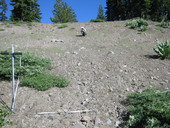Highlight
Alpine plant restoration on ski slopes
Achievement/Results
In mountain regions around the world, downhill ski areas represent a source of anthropogenic disturbance while also providing recreation and revenue. Ski run creation always results in some level of disturbance, but disturbance intensity varies greatly with construction method. Ski runs may be established either by clearing vegetation or by clearing and then machine-grading. To quantify how these different intensities of initial disturbance affect ecosystem properties, UC Davis graduate student Jennifer Burt and faculty member Kevin Rice extensively surveyed vegetation, soils, and environmental characteristics on cleared ski runs, graded ski runs, and adjacent reference forests across seven large downhill ski resorts in the northern Sierra Nevada in California. They found that the greater disturbance intensity associated with grading resulted in greater impacts on all ecosystem properties considered, including plant community composition and diversity, soil characteristics relating to processes of nutrient cycling and retention, and measures of erosion potential. They also found that cleared ski runs retained many ecological similarities to reference forests, and might even offer some added benefits by possessing greater plant species and functional diversity than either forests or graded runs. Because grading is more damaging to multiple indicators of ecosystem function, Burt and Rice recommend clearing rather than grading to create ski slopes wherever practical.
Further, Burt, Rice, and a botanist from the US Department of Agriculture (USDA) Forest Service are using the results of this research to develop seed mixes for use in revegetating ski runs. Although USDA Forest Service policy mandates the use of native species where possible in revegetation, ski slopes are more often seeded with nonnative grasses. Using extensive data on plant community composition of ski slopes from fourteen abandoned and seven active ski areas, Burt and the others identified native plants that are compatible with recreation, are abundant in the region, and that have naturally colonized ski slopes of this region. They currently are designing a project to experimentally test establishment success of many of these plant species on ski slopes across six National Forests, with the aim of improving ski slope revegetation practices. A long-term goal of this experimental study is to develop sites on ski slopes as sources of native-adapted seed for local revegetation projects.
Address Goals
Alpine ecosystems will be affected by global climate change in the coming decades. These ecosystems often are fragile because of the challenges imposed by life at high elevation with a short growing season and poor soils. Further, in some regions, climate change may have an economic impact if opportunities for winter recreation diminish.
The work by Burt and Rice has the potential to aid in planning restoration of ski runs and ameliorating the impacts of climate change on the plant community. In addition, revegetated ski runs offer the potential for extending recreational opportunities in the summer, thereby enhancing local economies.









